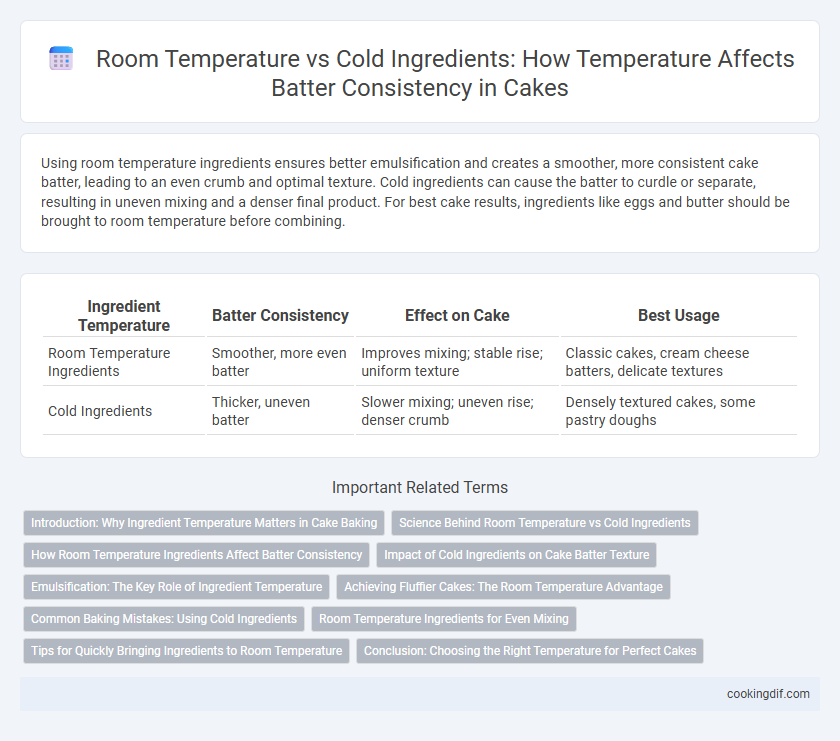Using room temperature ingredients ensures better emulsification and creates a smoother, more consistent cake batter, leading to an even crumb and optimal texture. Cold ingredients can cause the batter to curdle or separate, resulting in uneven mixing and a denser final product. For best cake results, ingredients like eggs and butter should be brought to room temperature before combining.
Table of Comparison
| Ingredient Temperature | Batter Consistency | Effect on Cake | Best Usage |
|---|---|---|---|
| Room Temperature Ingredients | Smoother, more even batter | Improves mixing; stable rise; uniform texture | Classic cakes, cream cheese batters, delicate textures |
| Cold Ingredients | Thicker, uneven batter | Slower mixing; uneven rise; denser crumb | Densely textured cakes, some pastry doughs |
Introduction: Why Ingredient Temperature Matters in Cake Baking
Room temperature ingredients blend more evenly, promoting a smoother batter consistency and better cake texture. Cold ingredients can cause uneven mixing, resulting in dense or lumpy cakes with irregular crumb. Understanding ingredient temperature is crucial for achieving consistent rise and optimal moistness in cake baking.
Science Behind Room Temperature vs Cold Ingredients
Room temperature ingredients, such as eggs and butter, blend more evenly into batter due to their similar molecular structure and viscosity, promoting uniform emulsification and air incorporation for optimal cake rise. Cold ingredients slow down the mixing process and can cause uneven fat distribution, resulting in a denser, less tender crumb. Scientific studies reveal that temperature affects the solubility of sugar and the crystallization of fat, directly impacting batter consistency and cake texture.
How Room Temperature Ingredients Affect Batter Consistency
Room temperature ingredients blend more smoothly, promoting a uniform batter consistency that improves cake texture. Warm ingredients help fats like butter and sugar to cream together properly, creating air pockets essential for cake rise and softness. Using cold ingredients can cause uneven mixing, leading to dense, lumpy batter and negatively affecting the final cake crumb.
Impact of Cold Ingredients on Cake Batter Texture
Cold ingredients in cake batter slow the melting of fats, resulting in a denser, less aerated texture that hinders optimal rise during baking. Room temperature ingredients blend more evenly, promoting better emulsification and smoother batter consistency, which contributes to a lighter, fluffier cake crumb. Using cold ingredients often leads to uneven texture and a heavier, more compact cake structure.
Emulsification: The Key Role of Ingredient Temperature
Ingredient temperature significantly impacts emulsification in cake batter, with room temperature eggs and butter facilitating better integration and stability of fat and liquid components. Cold ingredients slow down emulsification, causing uneven texture and reduced air incorporation, which affects the final cake crumb and rise. Optimal emulsification achieved with room temperature ingredients ensures a smooth, homogeneous batter, resulting in consistent texture and improved volume in baked cakes.
Achieving Fluffier Cakes: The Room Temperature Advantage
Using room temperature ingredients like eggs, butter, and milk promotes better emulsification, resulting in a smoother, more homogenous batter that traps air effectively. This improved air incorporation leads to a lighter, fluffier cake texture with enhanced rise and tenderness. Cold ingredients, in contrast, can cause uneven mixing and dense crumb due to insufficient aeration and incomplete integration.
Common Baking Mistakes: Using Cold Ingredients
Using cold ingredients in cake batter often leads to uneven mixing and a dense, heavy texture due to poor emulsification of fats and liquids. Room temperature ingredients, such as eggs, butter, and milk, blend seamlessly, creating a smooth batter that traps air effectively for a lighter cake crumb. Common baking mistakes involve ignoring the temperature of ingredients, which critically impacts the batter consistency and, ultimately, the cake's rise and fluffiness.
Room Temperature Ingredients for Even Mixing
Room temperature ingredients such as butter, eggs, and milk blend more uniformly, resulting in a smoother, more consistent batter texture that enhances the cake's final crumb and rise. Using cold ingredients can cause uneven mixing, leading to lumps or pockets of fat that negatively impact the batter's aeration and baking performance. Maintaining ingredients at room temperature ensures optimal emulsification and air incorporation, producing a tender, evenly baked cake.
Tips for Quickly Bringing Ingredients to Room Temperature
Using room temperature ingredients like eggs, butter, and milk ensures a smoother batter consistency and better emulsification, resulting in a lighter, fluffier cake texture. To quickly bring cold ingredients to room temperature, place eggs in a bowl of warm water for 10-15 minutes and microwave butter in short 5-second bursts until soft but not melted. Avoid heating milk directly; instead, let it sit in a warm water bath for a few minutes to gently raise its temperature without altering its properties.
Conclusion: Choosing the Right Temperature for Perfect Cakes
Room temperature ingredients blend more evenly, resulting in a smoother, lighter batter that yields a tender, well-risen cake. Cold ingredients cause uneven mixing and can lead to dense, uneven crumb texture. Selecting room temperature components optimizes batter consistency and ensures ideal cake structure and moisture retention.
Room temperature ingredients vs Cold ingredients for batter consistency Infographic

 cookingdif.com
cookingdif.com